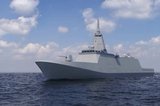German Armed Forces successfully concludes laser weapon demonstrator trials
The German Armed Forces began laser weapon demonstrator trials in June 2022. (Photo: MBDA)
The laser weapon demonstrator (LWD) had been integrated onboard the German Navy’s Sachsen F124 frigate in June 2022 and during the trials over six campaigns lasting nearly a year.
The combat effectiveness of LWD has, according to a statement from manufacturer from Rheinmetall, ‘been proven in increasingly complex scenarios under realistic operating conditions against different target types.’
Trials were planned and organised by the Federal Office of German Armed Forces Equipment, Information Technology and the In-Service Support along High-Energy Laser Naval Demonstrator Working Group consisting of MBDA Deutschland GmbH and Rheinmetall.
Trials included all aspects from detection and tracking, including of highly agile targets; the interplay of sensors, command and weapon engagement systems and effectors; possible rules of engagement; and the successful engagement of targets with a high-energy laser beam.
‘The LWD has performed more than a hundred test firings onboard the Sachsen and proved that a laser is capable of successfully engaging targets in a maritime environment,’ according to Rheinmetall.
‘The demonstrator is currently undergoing detailed examination, after which it will be transferred to the [German Armed Forces] Technical Centre 91 in Meppen. The test results and subsequent analysis will be used for minimising risks in a possible next phase, specifically the development of an operational laser weapon system.’
An operational LDW would complement gun-based systems and guided missiles, particularly in a C-UAS role but also in defeating speedboats and possibly missiles at close to very close range. It could undergo a performance upgrade for destroying supersonic missiles, rockets as well as mortar and artillery rounds.
Related Equipment in Defence Insight
More from Naval Warfare
-
![US Navy to acquire micro-uncrewed underwater vehicles for ISR and coastal data collection]()
US Navy to acquire micro-uncrewed underwater vehicles for ISR and coastal data collection
The Naval Supply Systems Command is seeking authorised resellers of JaiaBot uncrewed underwater vehicles and multivehicle pods. The platforms will support undergraduate education at the US Naval Academy.
-
![Future of the Canadian Patrol Submarine Project is still unclear]()
Future of the Canadian Patrol Submarine Project is still unclear
The Canadian government remains tight-lipped on the timeline and funding required for the next steps of its Canadian Submarine Patrol Project, which should offer improved capabilities for the country’s navy.
-
![Thales’ new Sonar 76Nano could equip UK Royal Navy on anti-submarine warfare missions]()
Thales’ new Sonar 76Nano could equip UK Royal Navy on anti-submarine warfare missions
The new sonar is designed to equip uncrewed underwater vessels, with the potential to be used by the Royal Navy for its Atlantic Bastion and Atlantic Net missions.






















